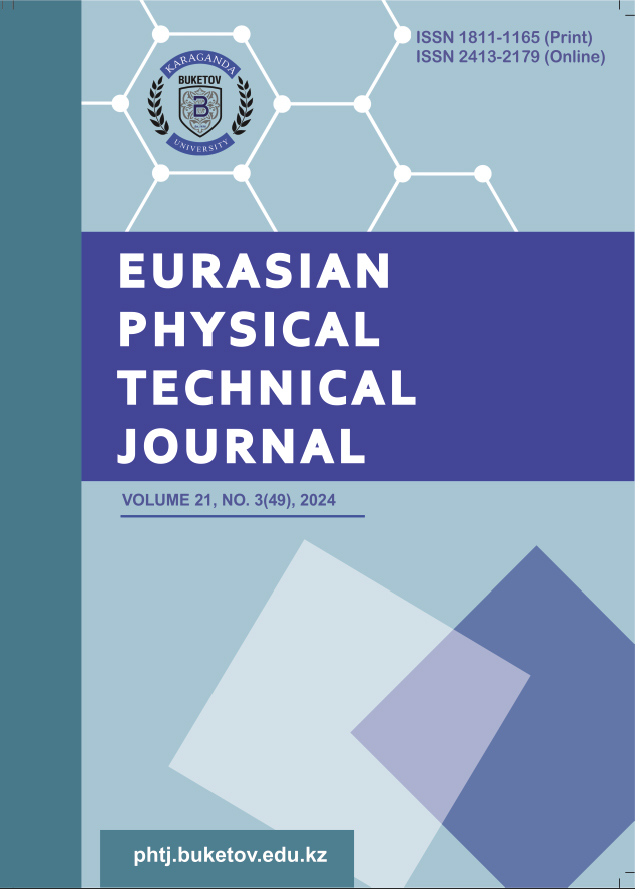Оптимизация влияния легирования и температуры на электрофизические характеристики p-n и p-i-n переходных структур.
DOI:
https://doi.org/10.31489/2024No3/21-28Ключевые слова:
плотность объемного заряда, концентрация легирующих примесей, моделирование, калибровка, оптимизацияАннотация
В данной работе исследовано влияние легирования и температуры (при 300 К и 400 К) на характеристики кремниевых (Si) и арсенид-галлиевых (GaAs) p-n и p-i-n гомопереходных структур, используя концентрации легирующих примесей p+=n+=2∙10¹⁷ и p=n=10¹⁶ см⁻³ посредством численного расчета и моделирования. Кроме того, проанализированы три различные случаи: A) p-n, B) p+-n и C) p-n+, чтобы исследовать их влияние на распределение объемного заряда, потенциала, электрического поля, неосновных носителей заряда и вольт-амперной (I-U) характеристики при 300 К. Из полученных результатов видно, что в случае A процесс рекомбинации не наблюдается при низком напряжении в симметричном p-n переходе по сравнению с асимметричными p-n переходами в случаях B и C. Затем были измерены вольт-температурные характеристики подготовленных образцов при температуре 300 К. Калибровка кремниевых p-n гомопереходов была выполнена с использованием экспериментальных данных для проверки предложенной модели. С помощью этой комплексной модели в нашей следующей работе будет исследовано влияние различных геометрических изменений, таких как радиальный p-n переход, на электрофизические свойства.
Библиографические ссылки
Shockley W. (1949) The Theory of p-n Junctions in Semiconductors and p-n Junction Transistors. Bell System Technical Journal, 28(3), 435–489. DOI: 10.1002/j.1538-7305.1949.tb03645.x.
Takeuchi D., Makino T., Kato H., Okushi H., Yamasaki S. (2011) Electron emission from diamond p-i-n junction diode with heavily P-doped n+ top layer. Physica Status Solidi (a), 208(9), 2073–2078. DOI:10.1002/pssa.201100140.
Pohl P., Renner F.H., Eckardt M., Schwanhäußer A., Friedrich A., Yüksekdag Ö., Gossard A. C. (2003) Enhanced recombination tunneling in GaAs pn junctions containing low-temperature-grown-GaAs and ErAs layers. Applied Physics Letters, 83(19), 4035-4037. DOI: 10.1063/1.1625108.
Goktas N.I., Wilson P., Ghukasyan A., Wagner D., McNamee S., LaPierre R.R. (2018) Nanowires for energy: A review. Appl. Phys. Rev., 5 (4), 041305. DOI: 10.1063/1.5054842.
Qiang Zeng, Na Meng, Yulong Ma, Han Gu, Jing Zhang, Qingzhu Wei, Yawei Kuang, Xifeng Yang, Yushen Liu (2018) Two-Dimensional Modeling of Silicon Nanowires Radial Core-Shell Solar Cells. Advances in Condensed Matter Physics, 2018, 7203493. DOI: 10.1155/2018/7203493.
Shin J.C., Chanda D., Chern W., Yu K.J., Rogers J.A., Li X. (2012) Experimental Study of Design Parameters in Silicon Micropillar Array Solar Cells Produced by Soft Lithography and Metal-Assisted Chemical Etching. IEEE Journal of Photovoltaics, 2(2), 129–133. DOI: 10.1109/JPHOTOV.2011.2180894.
Pylypova O.V., Evtukh A.A., Parfenyuk P.V., Ivanov I.I., Korobchuk I.M., Havryliuk O.O., Semchuk O.Y. (2019) Electrical and optical properties of nanowires-based solar cell with radial p-n junction. Opto-Electronics Review, 27(2), 143–148. DOI: 10.1016/j.opelre.2019.05.003.
Jung J.-Y., Guo Z., Jee S.-W., Um H.-D., Park K.-T., Hyun M.S., Lee J.-H. (2010) A waferscale Si wire solar cell using radial and bulk p–n junctions. Nanotechnology, 21(44), 445303. DOI:10.1088/0957-4484/21/44/445303.
Prabhat B.N., Balamurugan K. (2021) Characteristics and Modeling of PN Junction Diode in Verilog-A Including Reverse Recovery. Proceding of the IEEE 6th International Conference on Computing, Communication and Automation (ICCCA), Arad, Romania, 509 – 516. DOI: 10.1109/ICCCA52192.2021.9666261.
Khalid M., Raza W., Riaz S., Naseem S. (2015). Simulation and Analysis of Static and Dynamic Performance of Normally-off TIVJFET Using Sentaurus TCAD. Materials Today: Proceedings, 2(10), 5720–5725. DOI:10.1016/j.matpr.2015.11.117.
Kurbanov U., Zhumabaeva G., Dzhumanov S. (2024) New metal/superconductor-insulator transitions and their effect on high-TC superconductivity in underdoped and optimally doped cuprates. Eurasian Physical Technical Journal, 21, 1(47), 21–27. DOI: 10.31489/2024No1/21-27.
Arefinia Z., Asgari A. (2015) Optical and electrical modeling of solar cells based on graphene/Si nanowires with radial p–i–n junctions. Solar Energy Materials and Solar Cells, 137, 146 – 153. DOI: 10.1016/j.solmat. 2015.01.032.
Ferreira, Gabriel M., Vítor Silva, Graça Minas, Susana O. Catarino (2022) Simulation Study of Vertical p–n Junction Photodiodes’ Optical Performance According to CMOS Technology. Applied Sciences, 12, 5: 2580. DOI:10.3390/app12052580.
Abdullayev J.S., Sapaev, I. B. (2024) Optimization of The Influence of Temperature on The Electrical Distribution of Structures with Radial p-n Junction Structures. East European Journal of Physics, (3), 344-349. DOI:10.26565/2312-4334-2024-3-39.
Muhammed O.A., Danladi E., Boduku P.H., Tasiu J., Ahmad M.S., Usman N. (2021) Modeling and simulation of lead-free perovskite solar cell using SCAPS-1D. East European Journal of Physics, 2, 146-154.
Ali N.M., Allam N.K., Abdel Haleem A.M., Rafat N.H. (2014) Analytical modeling of the radial pn junction nanowire solar cells. Journal of Applied Physics, 116(2), 024308. DOI:10.1063/1.4886596.
Bal S.S., Basak A., Singh U.P. (2022) Numerical modeling and performance analysis of Sb-based tandem solar cell structure using SCAPS–1D. Optical Materials, 127, 112282.
Kelzenberg M.D., Boettcher S.W., Petykiewicz J.A., Turner-Evans D.B., Putnam M.C., Warren E.L., Atwater H.A. (2010). Erratum: Enhanced absorption and carrier collection in Si wire arrays for photovoltaic applications. Nature Materials, 9(4), 368–368. DOI:10.1038/nmat2727.
Shura M.W., Wagener V., Botha J.R., Wagener M C. (2012). Photoconduction spectroscopy of p-type GaSb films. Physica B: Condensed Matter., 407(10), 1656 – 1659. DOI: 10.1016/j.physb.2011.09.110.














